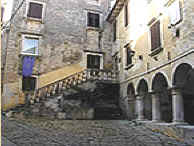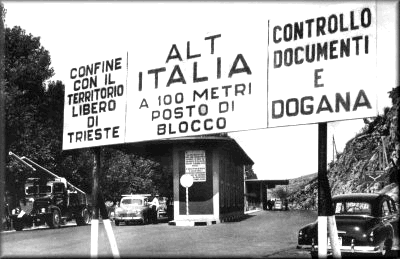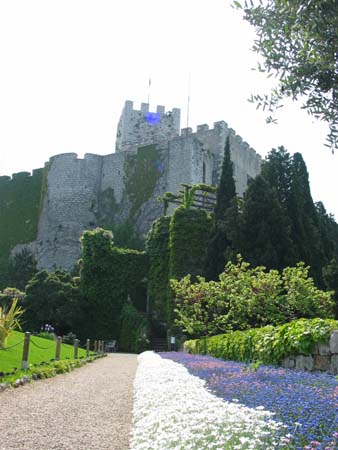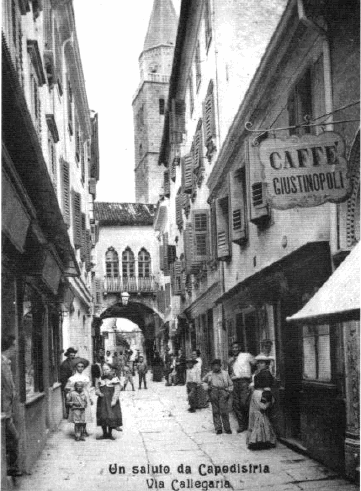|
|
FTT
- TLT
|
|
 |
|
|
|
|
|

MOMIANO
CITTANOVA
DAILA
VERTENEGLIO
|
|

CAPODISTRIA
|
|

TRIESTE
|
|

MUGGIA
|
|

GRISIGNANA
|
|

DUINO
|
|

PIRANO
|
|
THE 16 MUNICIPALITIES of THE FREE
TERRITORY of TRIESTE
|
- DUINO
|
- MUGGIA
|
- TRIESTE
|
- CAPODISTRIA
|
- ISOLA
|
- PIRANO
|
- UMAGO
|
- GRISIGNANA
|
- CITTANOVA
|
- VERTENEGLIO
|
- BUIE
|
- SGONICO
/ ZGONIK
|
- MONRUPINO
/ REPENTABOR
|
- MARESEGO / MAREZIGE
|
-MONTE DI CAPODISTRIA / SMARIJE
|
- SAN
DORLIGO DELLA VALLE / DOLINA
|
-
VILLA DE'CANI / DEKANI
|
| |
| |
The
Weather
in TRIESTE now
|
|
|
| |
| |
| |

Il
Territorio Libero
di Trieste
Il
TLT confina a
nordovest con la
Repubblica
Italiana, a est
con la Repubblica
Popolare di
Jugoslavia, e ad
ovest con il mare
Adriatico.
Fiumi:
Timavo, Rosandra,
Risano, Quieto
Massima
elevazione: Monte
Castellaro 742
m.s.l.m.
Clima:
marittimo
mediterraneo sulla
costa, temperato
continentale
all'interno.
Limite
Nord: Dosso Giulio
45.5 N
Limite
Sud: Porto Quieto
45.2 N
Limite
Ovest: Punta
Salvore 13.0 E
Limite
Est: Grozzana di
Pese 13.2 E
Data
Costituzione
10.2.1947
Superficie:
741 Kmq.
Comuni:
Duino, Aurisina,
Monrupino,
Sgonico, Trieste,
Muggia, San
Dorligo,
Capodistria,
Maresego, Monte di
Capodistria, Villa
Decani, Isola,
Pirano, Buie,
Cittanova, Umago,
Verteneglio,
Grisignana.
Popolazione:
330.000 ab.
----
278.000
Italiani, 35.000
sloveni, 13.000
croati, 4.000
tedeschi, altre
etnie.
Densità
: 444 ab/kmq.
Distribuzione
etnica
 Fonte: Karty
etniceskoj
struktury Juliskoy
krajny 1946:
Fonte: Karty
etniceskoj
struktury Juliskoy
krajny 1946:
Italiani
84%
Slavi
15%
Altri
1%
278.000
Italiani, 35.000
sloveni, 13.000
croati, 4.000
tedeschi ed altre
etnie.
Si
parla italiano (un
dialetto di tipo
veneto) nella
capitale Trieste,
nei centri
lungo la costa dal
Timavo al Quieto,
e nei loro
dintorni (Duino,Grignano,Trieste,
Muggia,
Capodistria,
Isola, Pirano,
Portorose,
Sta.Lucia,
Salvore, Umago,
Daila,
Cittanova),
nei
maggiori
centri
dell'interno
(Grisignano,
Momiano,
Castelvenere,
Buie, Verteneglio)
nonché nelle
campagne del
Muggesano,
Capodistriano,
Piranese e Isolano
e in quelle
del Buiese
ed Umaghese.
I
35.000 Sloveni
abitano l'
altipiano del
Carso da San
Giovanni di Duino
(Stivan) a nord, a
Monte di
Capodistria
(Smarje) a sud,
nonché, misti
agli
italiani, le
campagne e alcuni
dei sobborghi
retrostanti
Trieste (Barcola,
San Giovanni e
Servola) nonchè
la zona sopra
Muggia (Crevatini,
Albaro Vescovà) e
intorno
Capodistria
(S.Antonio, Villa
Decani).
Tutti
parlano
correntemente
anche
l'italiano.
In
zona A ricadono
28.000 sloveni, in
zona B solo
7.000.
I
13.000
Croati
abitano, misti
agli
italiani, le
campagne della
zona meridionale
del
Territorio, e
costituiscono
la
maggioranza
nelle campagne
più distanti
dalla costa
(intorno a Toppolo
in
Belvedere/Topolovec).
Tutti parlano
correntemente
anche l'italiano.
Risiedono tutti in
zona B.
I
4.000 abitanti
tedeschi e di
altre etnie sono
principalmente
concentrati a
Trieste( zona A).
Tutti parlano
correntemente
anche l'italiano.
Dei
18 singoli
municipi, 7
piccoli comuni
sono, nel 1947, a
maggioranza
slovena: in zona A
Nabrezina
(Aurisina), Zgonik
(Sgonico),
Repentabor
(Monrupino),
Dolina (
Sant'Ulderico)
e in zona B
Marezega (
Maresego), Dekani
(VIlla Decani) e
Smarje (Monte di
Capodistria)
Gli
altri 11
comuni , sono a
maggioranza
italiana: 3 in
zona A ( Duino,
Muggia, Trieste )
ed 8 in zona
B ( Capodistria,
Isola, Pirano,
Umago, Cittanova,
Buie, Verteneglio,
Grisignana ).
Nella
parte
settentrionale del
TLT, e in genere
in tutti i centri
urbani, tra
Italiani e slavi
la distinzione
nazionale è
netta. La
coscienza
nazionale è
chiaramente
delineata, i
fattori
linguistici,
culturali e
sentimentali, di
regola, non si
prestano ad
equivoci.
Scendendo
nelle campagne a
mezzogiorno della
Dragogna, quando
si entra in quella
parte della
campagna istriana
che è divisa fra
Italiani e
Croati, le
questioni
nazionali
cominciano a
perdere parte
della loro
nettezza : una
massa non
indifferente nelle
zone rurali, che
statisticamente
considereremo
croata, è
formata da
elementi incerti
bilingui,
parlanti un
dialetto ibrido
italo-slavo
(schiavetto) misto
tra
veneto,
sloveno e croato.
A
questo proposito
bisogna tener
presente che le
lingue slave della
regione non hanno
una diffusione
extra-nazionale e
non offrono ancora
risorse culturali
tali da invogliare
gli elementi
italiani ad
apprenderle. Di
regola gli
Italiani ignorano
la lingua dei loro
vicini, mentre gli
Slavi della
regione sono
bilingui da
secoli.
Composizione
etnica dei
principali centri
urbani ( esclusi
sobborghi e
circondari)
secondo l'I.R.
Censimento per
lingua d'uso.
Trieste:
91,2% It. - 4,7%
Ted. - 3,8% Sl.
Muggia
: 97,9% It. -1,9%
Sl. - 0,2% Ted.
Capodistria
: 89,7% It.
- 4,8% Ted. - 1,9%
Sl.
Isola
: 99,4 % It. -
0,6% Sl.
Salvore
80% It. 20% Cr.
Pirano
: 99,8 % It. -
0,2% Ted. -
Castelvenere:
65,3% It. 34,7 %
Cr.
Bandiera
: Corsaresca
(Alabarda) bianca
in campo rosso
Sigla
automobilistica
internazionale :
TLT
Ferrovie
AAFTLT
AZIENDA AUTONOMA
DELLE FERROVIE DEL
TLT ( il 19
settembre 1947 è
avvenuto il
passaggio gestione
da FS
italiane
alla AAFTLT
)
LINEE: Italia-
Confine-
Duino-Trieste
C.le.
Villa
Opicina-Aurisina-Barcola-Trieste
C.le.
Jugoslavia-Confine-Op.
Campagna-Guardiella-Trieste
St.Andrea.
Trieste
St.Andrea-Servola-Aquilinia.
Trieste
St.Andrea-Sant'Anna-St.Elia-Pirano-Santa
Lucia di
Portorose-Buie (in
esercizio fino
St.Elia).
POSTE:
nella zona A
l'Amministrazione
postale
utilizza
francobolli
italiani
sovrastampati con
la dicitura AMG
FTT, nella zona B
l'Amministrazione
jugoslava utilizza
propri francobolli
trilingui.
IL
MONOPOLIO DI STATO
DEL TERRITORIO
LIBERO DI TRIESTE
si occupa della
distribuzione del
tabacco e
sigarette, a
prezzi del 18 %
inferiori a quelli
italiani.
La
pressione fiscale
è del 20 %
inferiore a quella
in Italia alla
stessa epoca.
RADIO
: vengono
trasmessi un
programma in
italiano (Radio
Trieste) e uno
sloveno
(Radio Trst A).
Per la zona B
trasmette un
programma in
italiano
Forze
militari.
Nelle
due zone, come
previsto dallo
Statuto, non vige
l'obbligo di
servizio militare.
(In zona B però
gli jugoslavi
hanno introdotto
il lavoro
obbligatorio
paramilitarizzato)
La
Polizia civile
VGPF conta 4337
effettivi militari
e 5301 impiegati
La
Guardia di Finanza
del TLT conta 1044
effettivi militari
e 1206 impiegati
La
Polizia
amministrativa
conta 315
effettivi
Sono
presenti nella
zona A 5000
militari USA e
5000 britannici.
Nella
zona B sono
presenti 5000
militari
jugoslavi.
ELEZIONI
|
1948
|
1952
|
D.Cristiana
|
25
|
28
|
P.Com.
TLT
|
13
|
6
|
P.Soc.Ven.Giulia
|
4
|
5
|
M.Sociale
|
4
|
4
|
P.Socialista
|
*
|
1
|
P.Repubblicano
|
3
|
4
|
P.Liberale
|
1
|
3
|
Monarchici
|
3
|
1
|
Liste
Slovene
|
1
|
1
|
Comunisti
titini
|
1
|
1
|
F.te
Indipendenza
|
4
|
5
|
Blocco
Tr./Unione.Tr.
|
1
|
1
|
Territorio
Libero
di
Trieste
-
Presidenza
di Zona,
Ufficio
Elettorale
|
|
|
|
|
|
|
FREE TERRITORY OF TRIESTE
TERRITORIO
LIBERO DI TRIESTE
|
| |
 The
flag of the Free Territory
of Trieste was flying
1945/1954 in the A zone
ruled by the
American-British forces and
especially above the castle
of Duino,
which was the residence of
the Military Cdt of the said
zone, the General Officer
Commanding BETFOR (British
Element Trieste
Force). The
flag of the Free Territory
of Trieste was flying
1945/1954 in the A zone
ruled by the
American-British forces and
especially above the castle
of Duino,
which was the residence of
the Military Cdt of the said
zone, the General Officer
Commanding BETFOR (British
Element Trieste
Force).  The
flag was lowered on the 5th
of October 1954 when the
Italians regained this part
of the territory. The
flag was lowered on the 5th
of October 1954 when the
Italians regained this part
of the territory.
The
unique exemplar of the flag
flying above the castle of
Duino is kept now in the
collections of the Imperial
War Museum in London.
The
AMG in Zone A was protected
by two separate contingents
of Allied servicemen, 5,000
Americans in TRUST (TRieste
United States Troops) and
5,000 British in BETFOR
(British Element Trieste
FORce), each comprising
crack infantry battalions
complete with separate
American and British command
support units (Signals,
Engineers, Military Police,
etc) .Free Territory of
Trieste (FTT), established,
September 15, 1947, by
Proclamation No. 1 of the
Commander, British-United
States Forces, in his
capacity as Military
Governor, BUSZ, in
accordance with Section III
of the Treaty of Peace with
Italy, effective same day,
which established FTT under
United Nations (UN) auspices
and provided for its
provisional administration
until such time as a
governor, appointed by the
UN Security Council,
organized a permanent
administration. FTT,
consisting of the City and
Port of Trieste and
surrounding territory, was
divided into Zone A (which
included the City and Port),
administered by AMG, BUSZ;
and Zone B, administered by
organizations of the
Yugoslav Government. The
provisional administration
was continued, 1947-54,
because of the UN Security
Council's inability to agree
upon the selection of a
governor. By a Memorandum of
Understanding between the
Governments of Italy, the
United Kingdom, the United
States, and Yugoslavia,
signed October 5, 1954, and
subsequently accepted by the
UN Security Council, the
signatories agreed to an end
of FTT provisional
government and to the
transfer, with a slight
border adjustment, of Zone A
territory to Italy and Zone
B territory to Yugoslavia.
By same memorandum, Italy
agreed to maintain Trieste
as a free port in accordance
with terms of the Treaty of
Peace with Italy. AMG, BUSZ
abolished, October 26, 1954,
with territory under its
jurisdiction transferred to
Italian Government.
|
On
the 5th March 1946, Winston
Churchill, in an address to
Westminster College, Fulton,
Missouri, made his famous
"Sinews of War"
speech including the
following words:- "From
Stettin in the Baltic to
Trieste in the Adriatic an
Iron Curtain has come down
over Europe".
He
went on to say,
"....... the future of
Italy hangs in the
balance".
The
Peace Treaty
signed in Paris by
the Italian
government on 10
February 1947
officially
sanctioned the new
borderline and a
division of the
two zones within
the Free Territory
of Trieste, a new
political-administrative
unit which
extended from
Duino to Cittanova
in Istria and
which encompassed
330 000
inhabitants in 741
km2.
 Under
the terms of the
1947 Peace
Treaty with
Italy, a
Governor for the
Free Territory
of Trieste was
to be selected Under
the terms of the
1947 Peace
Treaty with
Italy, a
Governor for the
Free Territory
of Trieste was
to be selected
and appointed by
the United
Nations Security
Council. Until
such appointment
was made, the
United States,
Great Britain,
and Yugoslavia
were to
administer and
protect that
Territory.
Quarterly
reports were
submitted by the
Anglo-American
Allied Military
Government to the
United Nations,
detailing the
recovery and
evolution of that
part of the
Territory in their
"Zone
A".
 Provisions were
made in the Treaty
for the three
nations to provide
a garrison of
5,000 troops each
in
Provisions were
made in the Treaty
for the three
nations to provide
a garrison of
5,000 troops each
in
support of the
emerging
government, to be
withdrawn at a
point after the
Governor had taken
control of
the Territory.
Relations between
the American and
British
governments on the
one hand, and the
Yugoslav
government and
communist bloc on
the other hand,
were such that the
area of the
Territory was
divided
into two zones.
Zone A,
administered by
Allied Forces
Trieste - the
American and
British
contingents -
was primarily the
metropolitan area,
while Zone B,
administered by
the Yugoslavs, was
primarily the
hinterland.
The
Governor was never
appointed.
Although several
well-qualified
candidates had
been proposed,
the East and West
Blocs could not
come to agreement
on political and
strategic issues.
"Waiting
for a
Governor" ,
the FTT kept also
divided into two
zones.
The
truth was that
nobody knew how to
sweep off Tito's
Army from the B
zone.
Zone
A, was 222 km2
and had
262.000 inh.
(232.000 Italians,
25.000 Slavics,
4.000 Germans)
Was
comprising the
northern part,
administered by
the Allied
Military
Government (AMG)
including the
cities of
Trieste
(211.000 Italians
and 11.000
Slovenes) and
Muggia (13.000
Italians and 500
Slovenes), and
the rural
villages on the
highlands (22.500
Slovenes and 2.000
Italians).
Zone
B, was 529 km2 and
68.000 inh.
(54.000 Italians,
14.000 Slavics)
Yet
occupied by the
Yugoslavian Army
since May
1945.
This
zone continued to
be administered by
Yugoslavian
Military
Government
(STT-VUJA) and was
comprising the
southern part of
FTT,
including
urban
(overwhelming
Italian) areas (
Capodistria,
Isola, Pirano,
Buie, Cittanova,
Umago and others,
with 43.000
Italians and 1.900
Slovenes) and the
rural areas in the
north-west of the
Istrian Peninsular
( 12.000 Slovenes
or Croats, and
9.000 Italians).
The
G.M.A in the A
Zone
The
AMG in Zone A was
protected by two
separate
contingents of
Allied servicemen,
5,000 Americans in
TRUST (TRieste
United States
Troops) and 5,000
British in BETFOR
(British Element
Trieste FORce),
each comprising
crack infantry
battalions
complete with
separate American
and British
command support
units (Signals,
Engineers,
Military Police,
etc) 
In
1954, the FTT was
disbanded, Zone A
being handed over
to Italy and Zone
B was incorporated
into
Yugoslavia.
The
STT-Vuja in the B
Zone
The
political life of
the years of the
Allied Military
Government was
lived out
according to the
book in the A
Zone, whereas the
B Zone immediately
suffered the
Yugoslavian action
of violent
coercion against
the Italian
communities (80%
of population of
the zone)
.Italians
were the
overwhelming
majority,
particularly along
the coast (
up to 99 %).
Capodistria,
Isola and Pirano
were assigned to
Slovenes, the
southern areas
with Buie, Umago
and Cittanova to
Croats.
The
Yugoslavs, since
the first day,
made use of
intimidation
through nightly
summary arrests,
popular kangaroo
court trials, and
the fast
elimination of
Italian
professionals and
workers.
Yugoslavs
immediately took
over all shops and
enterprises, while
the majority of
fishermen and
farmers were
forced to work for
the Authority.
 In
April 1946 the
Slavic language
was
introduced
in the schools and
in the
administration of
the rural and
coastal areas,
where 97% of
the population
were Italian and
didn't normally
know even a single
word of Slavic
language. In
April 1946 the
Slavic language
was
introduced
in the schools and
in the
administration of
the rural and
coastal areas,
where 97% of
the population
were Italian and
didn't normally
know even a single
word of Slavic
language.
During
the nights Slovene
soldiers used to
introduce
themselves in the
homes and frighten
the Italian
autochthonous.
Who
had his job in the
A zone of FTT was
the first to
be invited
to leave
definitively the B
zone.
1900
Capodistria (now
Koper ), la via
Callegarìa.
Later
the
Slovenian and
Croatian military
authorities, in
order to
yugoslavize the
towns began taking
over "for
administrative
reasons"
the italian
private
homes.To the
displaced Italian
families the
Slovene Authority
normally proposed
a rural
house in an area
where the Italian
language was
completely banned
from schools and
administration.
People preferred
to move to Italy,
Australia and
America.
In
the area under the
Slovenian military
authority, i.e. in
Capodistria, Isola
and Pirano, the
job was very good
done, and
practically every
single
Italian
inhabitant (27.000
of 30.000) had to
move away . 
The
Yugoslavs tried by
all means to
obstacle the
circulation of
people and
merchandises
between the two
zones of FTT, and
simple workers
spent
sometimes until 10
hours to cross the
border between the
two zone of the
so-called
"Free"
territory, while
the farmers and
fishermen could no
more sell their
product in the
great town of
Trieste.
Even
if it was
formally
prohibited by the
Peace's Treaty ,
the Yugoslavian
Authority
introduced in 1948
a new worthless
currency : the
Yugolira.
Yugoliras
had practically no
worth (the Economy
in the B zone was
practically
reduced to zero),
but at the border
everyone was
entering the
yugoslav
zone (poor
workers coming
back to their
homes in the B
zone included) ,
had its money
obligatory changed
by Yug. military
authorities with
an absurd ratio
Lira 1:1 Yugolira.
The
Yugoslavs were
inciting the
little (but
steadily
increasing with
new forced
yugoslavian
immigration)
Slovene minorities
hatred of
Italians, all
depicted as
'bourgeois Fascist
Imperialists and
collaborators'.
The
majority of the
Italians,
without job a nd
without home,
terrified by
Slovenes ,
preferred to leave
the B zone and
emigrated to
Italy, Canada or
Australia. nd
without home,
terrified by
Slovenes ,
preferred to leave
the B zone and
emigrated to
Italy, Canada or
Australia.
Their
houses were given
to Slavic and
Moslem peasants
called from the
South of
Yugoslavia.
Still
today
historical centers
are partially
unoccupied.
(
Central Pirano
center had 7.000
inh. in 1945, but
has only 700 now)
It
was something
which was ongoing
not only in the
Ftt but in
the whole of urban
centers of the
former Italian
territories of the
eastern part of
Adriatic.
Since
1920 on the
Dalmatian coast,
and since 1944 in
Istria, Fiume and
Quarnero Islands.
Though
the exodus was not
as sudden as that
of the Albanians
in Kosovo, about
300,000 ethnic
Italians fled
socialist
Yugoslavia in the
decade following
World War II.
Violence,
deportations,
religious
persecution and
physical and
psychological
terrorizing made
many ethnic
Italians believe
they had no choice
but to leave their
homes on the
Istrian Peninsula.
Finally
all Italian,
including farmers
and fishermen had
to emigrate from
the B zone.
In
the following
years up to 40.000
Italians, from
workers and
fishermen to
professionals,
were forced to
mass migration or
'ethnic cleansing'
from zone B in a
forerunner of the
horrors that have
swept the Balkans
since the collapse
of the Yugoslav
federation.
Only
2.700 (of 20.000)
Italians remain in
the area under
slovenian control,
and 8.500 (of
30.000) in the
croate area.
So
ended the complex
events of the
eastern border,
which nonetheless
left open wounds,
with a human cost
– the foibe and
the exodus –
which can not
easily be
erased. The
situation of the
Italians who
remained across
the border was a
cause for
controversy, owing
to the
difficulties that
the Italian
communities face
still today
in openly
expressing their
own cultural
identity.
|
|
|
|
|